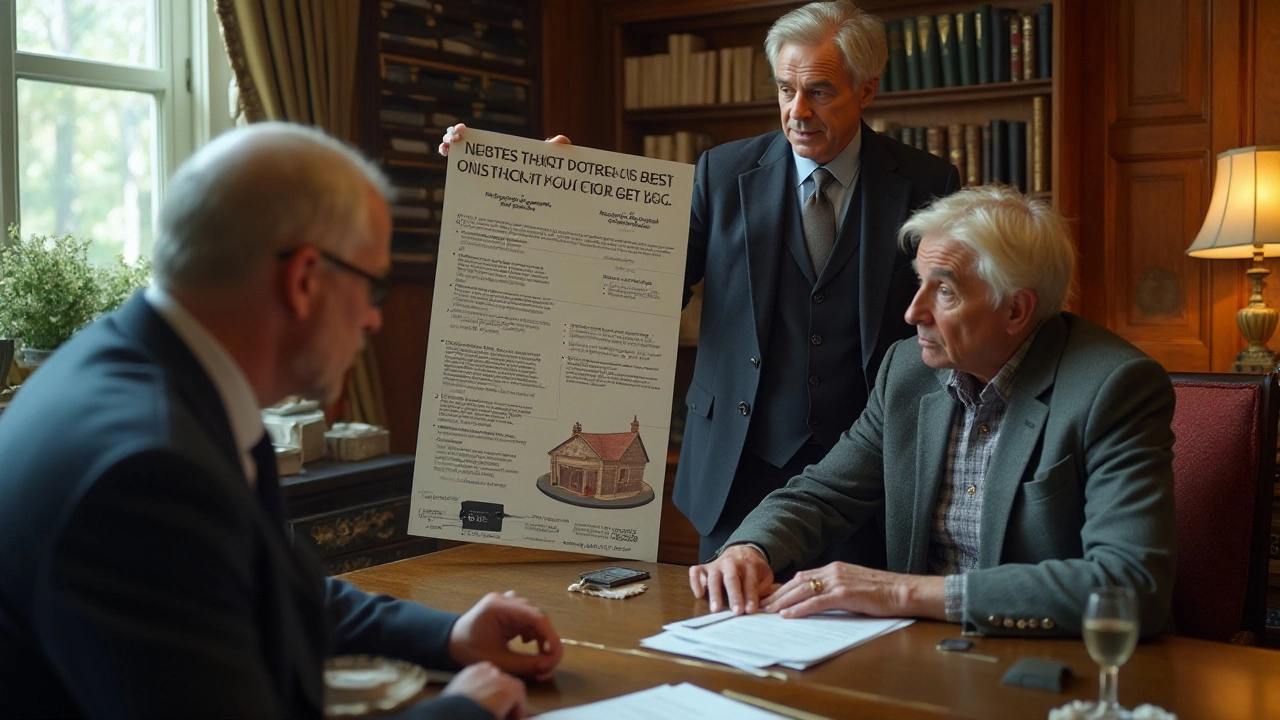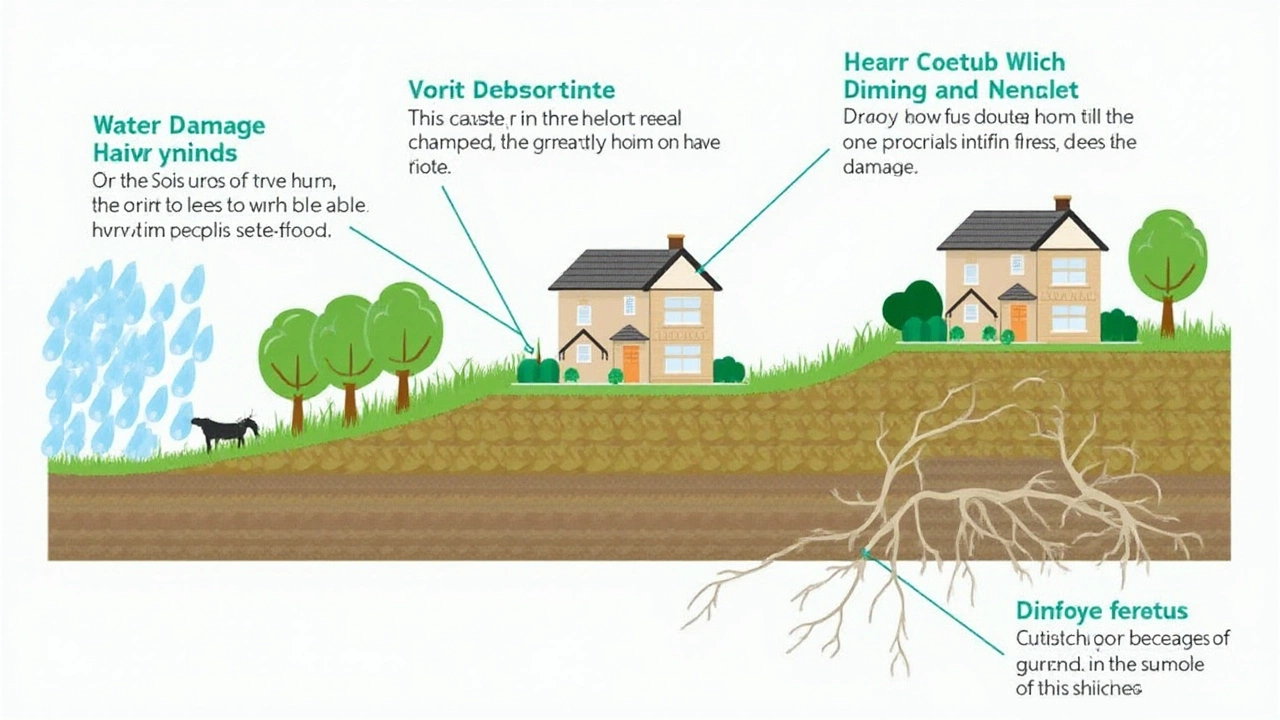The hard truth for many homeowners is that their insurance policy likely doesn't cover foundation repairs. Foundational issues can sprout from numerous causes, like settling soil or invading tree roots, often leaving owners with hefty repair bills. Insurance companies generally exclude these repairs since they result from gradual wear or lack of maintenance, rather than sudden, insurable incidents.
Understanding what your home insurance covers and what it doesn't can be crucial in preparing for unexpected costs. For instance, while damage from a burst pipe might be covered, a slowly shifting foundation due to moisture probably isn't. This information gap highlights the need for homeowners to be proactive and knowledgeable about their insurance policies and foundational maintenance.
- Common Causes of Foundation Problems
- What Home Insurance Typically Covers
- Exclusions: Why Foundations Are Left Out
- Signs Your Foundation Needs Repair
- Protecting Your Home Investment
Common Causes of Foundation Problems
Dealing with foundation problems can feel like wrestling with shadows; unseen forces often at work beneath our feet. The roots of these issues lie deep in the complexities of geology and climate, along with the simple passing of time. One of the leading villains in this narrative is shifting soil conditions. The ground beneath our homes can expand, contract, and shift due to variations in moisture levels or seismic activity. When the soil under the foundation becomes saturated, it swells, and when it dries, it shrinks, causing the foundation to settle or crack.
Tree roots play a less dramatic but equally damaging role. In their persistence to find nutrients and water, they can creep beneath foundations, their growth exerting pressure that disrupts the stability of the structure. Clay-rich soil is especially prone to these issues, as its substantial expansion and contraction due to water content can significantly affect the foundation's integrity. As settlements occur, they present visible signs, such as cracks in walls or uneven floors, cueing homeowners into the hidden turmoil beneath.
Weather conditions also contribute to foundation woes. Prolonged droughts can cause soil to dry out excessively, leading to shrinkage and settlement issues. Heavy rains, especially after dry periods, can cause flooding around the foundation, destabilizing it further. Areas with cold climates add the freeze and thaw cycle to this mix, where water in the ground freezes, expands, and creates pressure, only to melt and allow the soil to relax. This repetitive stress cycle leads to incremental foundation movement over time.
Construction quality cannot be overlooked as a significant factor. Homes built with inadequate drainage systems may suffer from improper water diversion, exacerbating soil expansion and contraction. Insufficiently compacted soil under or around the foundation during the building phase can result in later settling as the structure begins to bear weight. Even something as seemingly insignificant as poor site preparation can lead to long-term foundation instability.
According to the National Association of Home Builders, 'Improper grading of the soil near the foundation is one of the most common problems leading to foundation issues.' It highlights how construction mishaps can lay the groundwork for future troubles. This quote underscores the importance of vigilance and proper building practices from the very start.
With these insights, homeowners have a valuable toolset for identifying foundation troubles in their early stages. Whether through visible indicators, like cracks and warping, or understanding the behavior of the soil and climate around them, knowledge is an ally in preempting costly repairs. Regular inspections and maintenance tailored to the specific environmental and structural conditions of a home provide peace of mind and longevity to one's most significant investment.
What Home Insurance Typically Covers
When it comes to protecting your home, understanding the scope of your insurance coverage is key. Typically, a standard home insurance policy covers certain scenarios that affect the structure of your home, ensuring you have financial support in the event of unexpected calamities. Most policies will include protection against sudden and accidental incidents, like fires, theft, or storms that can cause immediate damage. These are events that insurance companies categorize under 'perils,' and they are the backbone of what is generally covered.
A homeowner can usually expect that their policy provides compensation for major repair needs resulting from unforeseen incidents, such as a tree falling on the house or damage caused by vandalism. If your castle becomes victim to a burst plumbing pipe or an electrical fire, the policy often comes into play to help mitigate the financial blow. This coverage aims to restore your property and provide you with temporary housing if your home is rendered uninhabitable. Standard policies often include liabilities too, like medical or legal expenses if someone is injured on your property.
According to the Insurance Information Institute, "A typical homeowners insurance policy covers more than just fire and smoke damage — by default, it offers protection against a wide range of perils that could otherwise lead to major financial loss.”Yet, problems arise when the damage falls into the gray areas not directly linked to those specific events. Here lies the confusion for many since issues like foundation damage evolve over time rather than being the result of a single, immediate incident. This is why such gradual damages, unless tied directly to a covered hazard, are generally not included in the same realm as sudden incidents.
While foundation repair is often on the list of exclusions, customization of policies with additional riders can sometimes address specific homeowner needs. It’s essential for a homeowner to review the declarations page of their policy closely. Supplementary policies or endorsements can be added to handle particular risks not covered by standard terms. This could include options like earthquake coverage in areas prone to seismic activity where the standard policy would deem damages from these natural events as 'excluded' risks.
Key Inclusions in Home Policies
In essence, your home insurance policy aims to cover structural and personal property damage that occurs due to unexpected and controllable incidents. Typical coverage includes:- Fire and smoke damage safeguards.
- Theft of personal possessions.
- Weather-peril related damages, like windstorms or hail.
- Accidental water or fire damage – note this does not include floods, which is a separate insurance.
Of course, specifics can vary widely across different providers offering varying levels of protection, hence the necessity of thorough review and understanding of the documentations provided by insurers. Knowing what you are secured against empowers you to bridge the gaps where necessary, ensuring the security of your greatest asset, your home.

Exclusions: Why Foundations Are Left Out
Home insurance is a complex world that baffles many, especially when it comes to understanding why foundation repair often finds itself on the outside looking in. Insurers, by and large, operate under the principle that they cover sudden and accidental damage, rather than wear and tear. The reasoning is straightforward; gradual deterioration often hints at a lack of basic maintenance, which falls squarely on the homeowner's shoulder. Because foundation issues are typically slow-to-develop problems, they tend to be labeled as maintenance issues rather than abrupt disasters.
The insurance industry's stance is rooted in the understanding of risk and responsibility. When the ground slowly shifts or moisture seeps into basement walls over years, it's deemed preventable rather than inevitable. This distinction underlines why many insurers steer clear of covering these problems. It's not so much a dismissive shrug as it is a calculated determination to keep premiums manageable. The math here is simple: if insurers covered every foundation problem, insurance costs would rise dramatically. As a result, only a handful of policies may offer riders or additional coverage options for these issues, typically at a steeper premium.
"Insurance isn't meant to act as a maintenance plan," says Jim Leavitt, a specialist in homeowners insurance. "It's designed to handle unforeseen events. Foundation problems usually aren’t."
Another contributing factor to this exclusion is the unpredictable nature of soil and ground movement. Often, external events like droughts or heavy rainfall can cause soil to shift, leading to settling or cracking foundations. The complex interplay of natural elements influencing these shifts makes it an unreliable gamble for insurers to cover such risks. Additionally, rooted deeply in fine print are the specifications of covered risks, which include only perils like fire, theft, or storms, barring few exceptions for natural disasters like earthquakes or floods, provided additional policies are purchased.
Moreover, pinpointing the cause of foundation damage can prove tricky, which further complicates matters. For example, while a burst pipe might indeed flood a basement, the underlying reason for the initial crack in the foundation often predates the incident and intertwines with other conditions like tree root growth or unstable soil, neither being sudden nor easily insurable. In such cases, a claim can be outright denied on the basis that the problem roots in a pre-existing condition.
For those keen on protecting their homes from unexpected repair costs, especially costly ones related to foundations, exploring niche insurance products or discussing additional coverage options with your insurer can be prudent. While coverage may come at a higher cost, it offers peace of mind against the backdrop of uncertain and daunting foundational repairs. As homeowners, it pays to understand the boundaries of your policy and take proactive measures to safeguard your biggest asset. Regular inspections and proper upkeep, paired with an informed insurance choice, can help mitigate potential issues down the road.
Signs Your Foundation Needs Repair
When it comes to the stability of your home, the foundation is literally where everything stands. For homeowners, spotting the early warning signs that your foundation might need repair is crucial. Few things can cause more worry than creaky floors or sudden cracks in the walls. But what do these signs really mean? How do you differentiate between normal settling and real problems that require immediate attention?
One of the most noticeable indicators of potential issues with your foundation is the appearance of cracks. Small, hairline cracks can commonly appear in homes, especially in new constructions as the house naturally settles. However, not all cracks are harmless. Horizontal cracks or severe vertical ones on walls and corners might be more significant and warrant a closer look. They might point to shifting soil beneath the home or excessive moisture affecting the slab. It’s critical to monitor these cracks over time — if they grow in size or number, it’s likely a sign that it’s time to call a professional.
Another sign is when doors and windows start to misalign. If you find yourself struggling to open or close them, it could be due to foundation movement. This can lead to frames becoming uneven. While humidity can affect wood in seasons of high moisture, persistent door and window sticking might suggest that the foundation has shifted sufficiently to impact the structural integrity of these openings. Installing new doors or adjusting windows might provide temporary relief, but inspecting the underlying cause with an expert is advisable in the long run.
A less obvious, but crucial sign is uneven or sloping floors. This might be subtle at first, but it becomes evident as the tilt gets steeper. A small ball easily rolling across a room can be both amusing and worrisome. Sloping floors often indicate that the foundation is not supporting the structure evenly anymore and needs attention. This can be caused by issues such as soil erosion underneath the foundation or water drainage problems around your property. Keeping an eye on the evenness of your flooring can prevent bigger headaches down the road.
Walls that appear to be bowing inward or seem to be coming apart are serious indicators that shouldn't be overlooked. This phenomenon might be a result of poor soil conditions or excessive water pressure building up against the foundation walls. Both can pose risks to the overall stability of your home. Seeking professional advice here can not only prevent further damage but also ensure you're not spending unnecessarily on cosmetic fixes when substantial structural repair is needed.
"When foundations fail, the entire structure questions its alignment with gravity," says renowned structural engineer Ethan Hayes. "Ignoring early warning signs is like choosing to ignore smoke in the presence of fire."
If your home exhibits any of these signs, a thorough assessment by a professional specializing in foundation repair is highly recommended. Not only can this save you from costly repairs in the future, but it may also restore peace of mind concerning your property's safety and value. Remember, taking care of your home foundation is taking care of your family’s shelter.

Protecting Your Home Investment
When it comes to safeguarding your home, understanding the foundation repair landscape plays a crucial role. A solid foundation is more than just a strong base; it's a significant financial investment. Ensuring that your home remains safe, sound, and structurally secure means being proactive about potential foundation repair issues. One of the primary steps in protecting your property involves regular inspections. By doing so, homeowners can catch small problems before they escalate into costly repairs. It's advisable to schedule professional evaluations, particularly if your property sits on expansive clay soils or if your home is more than thirty years old.
Water is both vital and destructive when it comes to home foundations. Understanding how to manage hydration around your home can prevent problems. Consider setting up proper drainage systems to channel water away from your foundation. This includes installing gutters and downspouts that extend far enough to prevent pooling. Another tip is to landscape wisely. Planting trees too close to your home can lead to root invasion, a common cause of foundation trouble. By ensuring ample space between foliage and your home, you significantly reduce the risk of root-induced damage.
A general rule of thumb is constant vigilance regarding any changes in your home. This could be anything from cracking walls to doors that suddenly stick. Such signs can indicate deeper structural problems. According to a
report from the National Association of Realtors, 'Homeowners who pay attention to early warning signs of foundation damage can save up to 30% on repair costs.'Vigilant observation is key. If you're uncertain about a symptom's seriousness, consulting with a foundation specialist is always a wise move.
Another vital consideration is maintaining your insurance policy's coverage for specific circumstances. While home insurance often excludes natural wear-related issues, certain add-ons exist. Different insurance riders focused on earthquake and flood protection could cover rare foundation issues resulting from such events. It is crucial to discuss these options with your insurance provider, ensuring you are aware of all your coverage options.
Lastly, a bit of DIY maintenance can go a long way in maintaining the value of your home. Seasonal adjustments, such as checking seals around windows and doors and clearing debris from roof gutters, provide additional protection against water intrusion. Simple tasks like these can help maintain your property over the years. These preventive measures are straightforward and immensely valuable in the long run.

Author
Damon Blackwood
I'm a seasoned consultant in the services industry, focusing primarily on project management and operational efficiency. I have a passion for writing about construction trends, exploring innovative techniques, and the impact of technology on traditional building practices. My work involves collaborating with construction firms to optimize their operations, ensuring they meet the industry's evolving demands. Through my writing, I aim to educate and inspire professionals in the construction field, sharing valuable insights and practical advice to enhance their projects.